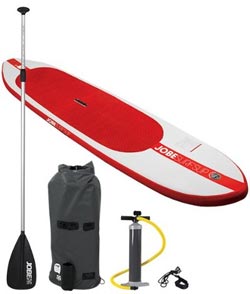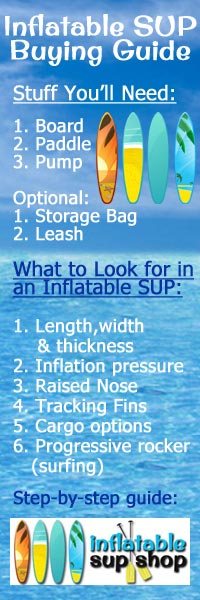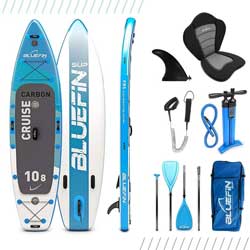If you are new to paddleboarding, you may not know how to shop for a paddleboard – let alone an inflatable one. The good news is that it’s not that difficult, since you don’t have that much equipment or gear to deal with. Plus, if you are a beginner, you don’t have to worry about a lot of fancy features that you just won’t use.
The Equipment You’ll Need:
 First things first, you will need a paddleboard and a paddle. There are special paddles designed for paddleboarding that have a wide angled paddle and hand grip for your upper hand. That said, you can use any paddle you want, it may just not be as comfortable or push as much water.
First things first, you will need a paddleboard and a paddle. There are special paddles designed for paddleboarding that have a wide angled paddle and hand grip for your upper hand. That said, you can use any paddle you want, it may just not be as comfortable or push as much water.
With inflatable boards, you need a pump. Some boards you can purchase with a pump, and this package deal generally is cheaper than buying the two separate (and no, you can’t use just any old pump – you need one that can fill at a high pressure and fits the fill opening on the board. I wondered this myself).
In some cases, the package deals also include a carrying bag, which is very convenient for transporting but also storing your board. These are typically made of heavy duty fabric and some are designed with backpack straps for easier carrying (and they look cool too!).
Something else you may want to look into is a leash, which attaches to the board and your ankle/calf. This will keep your board from escaping from you if you fall off. It’s meant more for paddling in aggressive surf.
The US National Whitewater Center also recommends a PFD (personal flotation device), especially if you are paddling rapids or not an experienced swimmer.
 What to Look for in an Inflatable Paddleboard
What to Look for in an Inflatable Paddleboard
1. Size:
Just like a non-inflatable board, smaller people use smaller boards and taller heaver people use wider, longer boards. Also, if you are a beginner, a larger board will offer greater stability. Narrower boards are designed more fore experienced boarders who already have good balance and want to have better navigation abilities with a board. Average board length is about 10 feet, which can work just fine for pretty much anyone.
2. Inflation:
Inflation pressure varies by board, typically being between 10 psi and 15 psi. The greater the psi, the more firm the board will be. Boards that are designed for higher inflation levels can be more expensive because they require stronger materials and design. They offer easier navigation and perform better in waves (ie. paddle surfing).
3. Other Nice Features:
Performance: A raised board tip can increase performance. Tracking fins are often included that you attach to the base. These help with navigation in calmer waters like lakes.
Comfort and Convenience: Most boards have a foam traction area. This makes it easier to grip the board while standing without slipping around and falling off all the time. Some boards come with metal rings, cords or straps on top where you can attach bags or other cargo, so you can carry items securely while paddling.
4. About Package Deals:
Paddleboard packages can include the board, paddle, patch kit, pump and carrying bag (some or all of these items). Tip: These can be great deals if the paddle is the right length for you – make sure you check.
Shopping for a Paddleboard Paddle
Paddles designed for paddleboarding are pretty similar to each other. In other words, there’s not much variety to choose from – which makes choosing one easy.
The key thing to keep in mind is length. Get one that is 6″-8″ taller than you. The right length will be more comfortable to use and be easier on your back. If multiple people will be using it, consider getting an adjustable paddle. Paddles generally run between $100 and $200, and you can get a decent one for around $120 if you shop around.

